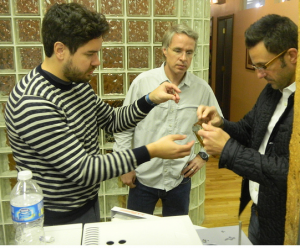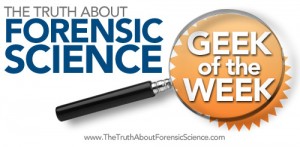The Forensic Science Geek of the Week
Please visit the www.TheTruthAboutForensicScience.com FaceBook fan page.
The week 71 “www.TheTruthAboutForensicScience.com Forensic Science Geek of the Week” honors goes to: William Herringer, Esquire

About our winner according to his website:
Attorney William Herringer is a trial litigator who is located in Durango, CO. He is a partner in Greenberg & Herringer, LLC. Greenberg & Herringer LLC, Durango area attorneys at law, practice in both criminal defense and family law. They can handle cases before federal, state and tribal courts and can provide legal help to those in La Plata, Montezuma, Archuleta, San Juan, San Miguel, Ouray and Montrose Counties. They offer counseling for criminal matters including felonies, drug, DUI/DWAI and domestic violence. They will handle family law cases including divorce, child custody, alimony & support and mediation.He defends motorists who are accused of a DUI. Herringer also is a member of the National College for DUI Defense Incorporated. He most recently completed the 5 day intensive hands-on ACS Forensic Chromatography Course held at Axion Analytical Laboratories, Inc. in Chicago Illinois.
Congratulations to our Forensic Science Geek of the Week winner!
OFFICIAL QUESTION:

- The Forensic Science Geek of the Week Challenge
1. What specific technique is depicted in this photo?
2. Explain it.
3. What are its limitations?
Our Geek of the Week answered:
Answer to Week 61 Question
1. What specific technique is depicted in this photo?
Time of Flight Mass Spectrometer
2. Explain it.
A time-of-flight mass spectrometer uses the differences in transit time through a drift region to separate ions of different masses. The ions from the ion source are accelerated by an electric field pulse. The accelerated particles then pass into a field-free drift tube that is about a meter in length.
The essential principle of time-of-flight mass spectrometry is that all ions are accelerated to the same kinetic energy. Their velocities are inversely proportional to the square roots of their masses. The lighter ions of high velocity arrive at the detector earlier than the heavier ions of low velocity.
3. What are its limitations?
-Requires pulsed ionization method or ion beam switching (duty cycle is a factor)
-Fast digitizers used in TOF can have limited dynamic range
-Limited precursor-ion selectivity for most MS/MS experimentsAll answers (including identifying the picture) obtained using Google and cut and pasted into this post. Don’t know if that is cheating, but it was the only way I was going to get the answer.
[BLOGGER’S NOTE: What a great answer. Thank you for participating. Congratulations on being our Geek of the Week. Just to further amplify. Time of Flight Mass Spectrometry (TOF-MS) is very good at determining the molecular ion that then can be used to deduce what possible compound it could be. As it is simply like a proverbial foot race to the detector, there is not going to be a lot of mass spectral information on the mass spectra produced. So, in terms of positive and conclusive qualitative analysis, it is not as useful as QqQ or NMR. It is very fast analysis. It is a high throughput device. Theoretically, there should be no limit to the molecular weight/mass that can be examined. It has a very tight and limited linear dynamic range. It should not be a first choice for quantitative analysis.]
The Hall of Fame for the www.TheTruthAboutForensicScience.com Forensic Science Geek of the Week:
Week 1: Chuck Ramsay, Esquire
Week 2: Rick McIndoe, PhD
Week 3: Christine Funk, Esquire
Week 4: Stephen Daniels
Week 5: Stephen Daniels
Week 6: Richard Middlebrook, Esquire
Week 7: Christine Funk, Esquire
Week 8: Ron Moore, B.S., J.D.
Week 9: Ron Moore, B.S., J.D.
Week 10: Kelly Case, Esquire and Michael Dye, Esquire
Week 11: Brian Manchester, Esquire
Week 12: Ron Moore, B.S., J.D.
Week 13: Ron Moore, B.S., J.D.
Week 14: Josh Lee, Esquire
Week 15: Joshua Dale, Esquire and Steven W. Hernandez, Esquire
Week 16: Christine Funk, Esquire
Week 17: Joshua Dale, Esquire
Week 18: Glen Neeley, Esquire
Week 19: Amanda Bynum, Esquire
Week 20: Josh Lee, Esquire
Week 21: Glen Neeley, Esquire
Week 22: Stephen Daniels
Week 23: Ron Moore, B.S., J.D.
Week 24: Bobby Spinks
Week 25: Jon Woolsey, Esquire
Week 26: Mehul B. Anjaria
Week 27: Richard Middlebrook, Esquire
Week 28:Ron Moore, Esquire
Week 29: Ron Moore, Esquire
Week 30: C. Jeffrey Sifers, Esquire
Week 31: Ron Moore, Esquire
Week 32: Mehul B. Anjaria
Week 33: Andy Johnston
Week 34: Ralph R. Ristenbatt, III
Week 35: Brian Manchester, Esquire
Week 36: Ron Moore, Esquire
Week 37: Jeffrey Benson
Week 38: Pam King, Esquire
Week 39: Josh Lee, Esquire
Week 40: Robert Lantz, Ph.D.
WEEK 41: UNCLAIMED, IT COULD BE YOU!
Week 42: Steven W. Hernandez, Esquire
Week 43:Ron Moore, Esquire
Week 44: Mehul B. Anjaria
Week 45: Mehul B. Anjaria
Week 46:Ron Moore, Esquire
Week 47:Ron Moore, Esquire
Week 47:Ron Moore, Esquire
Week 48: Leslie M. Sammis, Esquire
Week 49: Ron Moore, Esquire
Week 50: Jeffery Benson
Week 51: Mehul B. Anjaria
Week 52: Ron Moore, Esquire
Week 53: Eric Ganci, Esquire
Week 54: Charles Sifers, Esquire and Tim Huey, Esquire
Week 55: Joshua Andor, Esquire
Week 56: Brian Manchester, Esquire
Week 57: Ron Moore, Esquire
Week 58: Eric Ganci, Esquire
Week 59: Ron Moore, Esquire
Week 60: Brian Manchester, Esquire
Week 61:William Herringer, Esquire
Week 62: UNCLAIMED IT COULD BE YOU!
Week 63: Ginger Moss
Week 64: Richard L. Holcomb, Esquire
Week 65: John L. Buckley, Esquire
Week 66: Jeff Sifers, Esquire
Week 67: UNCLAIMED. IT COULD BE YOU
Week 68: Dr. Barbara Vonderhaar, PhD.
Week 69: Christine Funk, Esquire
Week 70: Mehul B. Anjaria
Week 71: Ron Moore, Esquire



